The Beginners Guide to SEO
SEO. A three-letter word that can potentially change your life and the fade of your business. Why? Through SEO you can take advantage of the millions of users that use search engines on a daily basis.
Search Engine Optimization is the key to online success. With SEO you can optimize your website for search engines and this means higher rankings in their results, more traffic to your website and potentially more customers.
If you want to change careers and start making a living online or you want to start selling products or services online or get more customers to your brick and mortar store, SEO is the most valuable and effective digital marketing tool you can use.
Who is this guide for?
This is a complete guide for those that are new to SEO.
We assume that you have no prior experience with search engine optimization or Search Engine Marketing and you will learn everything you need to know in simple terms by avoiding technical terms or jargon that can be confusing for beginners.
What to expect from this SEO Guide?
This is an introduction to SEO and it only touches the basics of SEO. It’s a beginner’s guide that will teach you the basic SEO concepts and set the ground so that you can move on to the more advanced SEO techniques.
By reading this guide you will not become an SEO expert but you will have the necessary knowledge to start implementing SEO on your website.
What to do next?
Once you are done reading this guide, you can continue your SEO learning journey with The Complete SEO Course, and learn everything you ever need to know about SEO.
It covers both basic and advanced SEO concepts with step-by-step guides, videos, real examples, and SEO case studies.
Our students wrote in their testimonials that it’s one of the fastest and easiest ways to learn SEO this year.
SEO Guide Contents
The following topics are covered in this guide:
How Search Works
Before getting into the specifics of SEO, the first thing to understand as a beginner is how search engines work.
Chances are, you have used Google thousands of times so far and until now you did not care how it works but only to find what you were looking for fast.
Knowing how Google works will help you get an idea of what we want to accomplish with SEO.
Search engines have become a part of our daily life. Whenever you have a question, want to learn or buy something, the first thing to do is open Google and perform a search either by typing your query in the Google search box or through voice search.
You expect to find what you are looking for within seconds and you mechanically click one of the top results returned by Google Search.
This process is performed around 3.3 billion times per day from users around the globe!
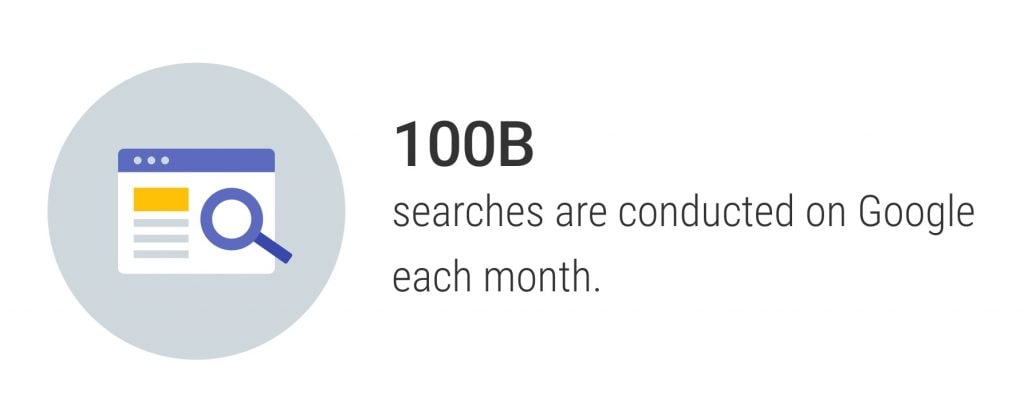
In order for Google to be in a position to respond to search requests fast and provide accurate results, they have to do a lot of preparation work in advance.
Their process is broken down into 2 major steps:
- Crawling and Indexing
- Ranking process (search algorithms)
Crawling and Indexing
During this process, Google creates an index of ALL the websites that are publicly available on the Internet.
Think of this like a telephone catalog but much bigger and instead of keeping names and telephones it keeps key information about a web site like The unique address of a site (URL), the title of the website, how many pages it has, the type of content, images, internal and external links and many more details that are needed by stage 2 (the ranking process).
To achieve this, Google has a number of programs called spiders (aka crawlers or bots) that crawl the web, gather and enter this information in the Google database for further processing.
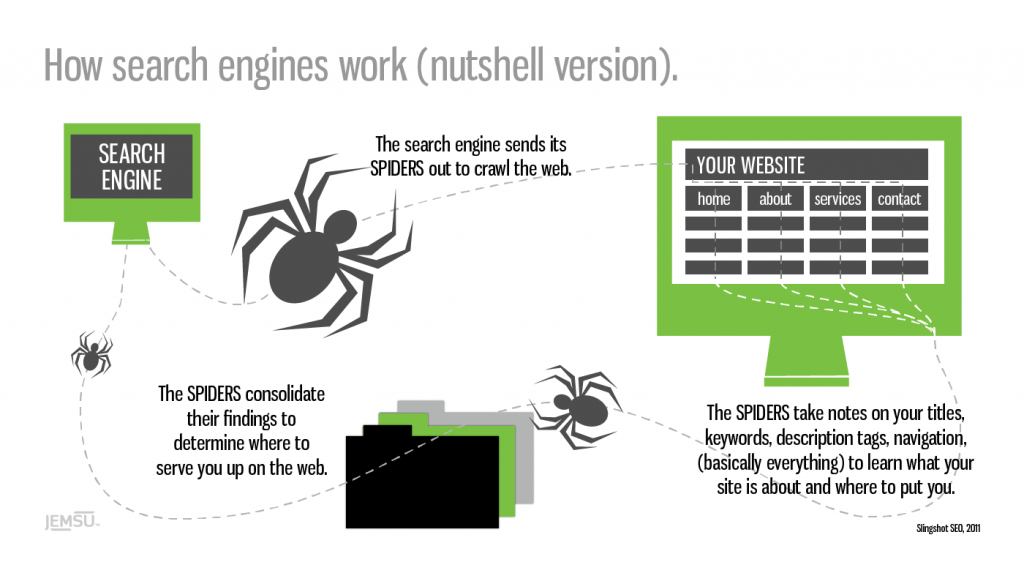
The crawlers are responsible for finding new pages but also monitoring existing pages for changes.
Over the years Google has become really good at this and they can identify and index important information almost instantly (i.e. breaking news like an earthquake).
They have hundreds of spiders monitoring the web and a huge database of storing and processing all the information.
KEY LEARNINGS
The way crawling and indexing works is too technical and you don’t need to know the fine details. What you need to understand now is that Google (and other search engines) are constantly monitoring the web for new content and for changes to existing content.
Ranking Process and Search Algorithms
When you type a query into the Google search box, Google has to understand what you are looking for and either tries to give you a direct answer or present you with a list of websites that are most likely to satisfy your request.
This is the job of search algorithms that run during the ranking process.
Search algorithms are complex computer programs that analyze the data in the Google index and make decisions as to which websites to show in the results for any given query, and at what order.
The Google search algorithm is made up of hundreds of rules but nobody knows exactly what these rules are.
The initial algorithm was created by the Google founders (Larry Page and Sergey Brin) back in 1996. At the beginning the algorithm was simple but over the years it has become very complex. It is believed that it takes more than 255 factors into account before making a decision.
Recently Google incorporated their Artificial Intelligence (AI) technology into the search algorithm (this is called RankBrain) so now the ranking decisions are made by both robots and the logic that is maintained by humans.
Over the years many engineers tried to decrypt the algorithm and understand exactly how ranking works but it still remains Google’s valuable secret.
There are some known factors that Google admitted to being part of the algorithm (like page speed, information security (SSL) and mobile-friendliness) but the rest were never officially released or admitted by Google.
Watch the short video (made by Google), which explains how Google search works.
KEY LEARNINGS
One of the goals of search engine optimization is to provide Google with the right signals so that during the ranking process, the search algorithm will ‘pick up’ your site and show it on top of the search results.
We will examine this in more details below, what you need to understand now is that the ordering of the search results is decided by the ranking algorithm after taking into account a number of known and unknown factors.
What about BING and other search engines?
Google is the most popular search engine with more than 60% market share but it’s not the only one. There are other search engines like Bing, Yandex, duckduckgo that hold the other 40% of the market.
In general, whatever optimization changes you make to your website to satisfy the search giant will help your rankings in other search engines as well.
What is SEO
Search Engine Optimization or SEO is the process to follow to optimize your website for search engines.
The SEO process has a set of rules you can apply to your website to make it easier for search engines to index your website and understand your content better.
Remember that crawlers and algorithms are not humans but computer programs and they cannot ‘read or see’ a website like real users.
Crawlers read the HTML code of a webpage, extract the information they need and add it to the index.
Then it’s the job of algorithms to decide which websites to rank higher for certain queries.
During this continuous process, both crawlers and algorithms are looking for clues to help them make the right decisions and websites that can do this more efficiently, rank higher in the search results.
This is what SEO is all about.
SEO Components
As mentioned above, the Google ranking algorithm takes into account more than 255 ranking factors when assessing the quality of a webpage.
To make it easier to handle, the various SEO factors can be grouped into three major sub-processes.
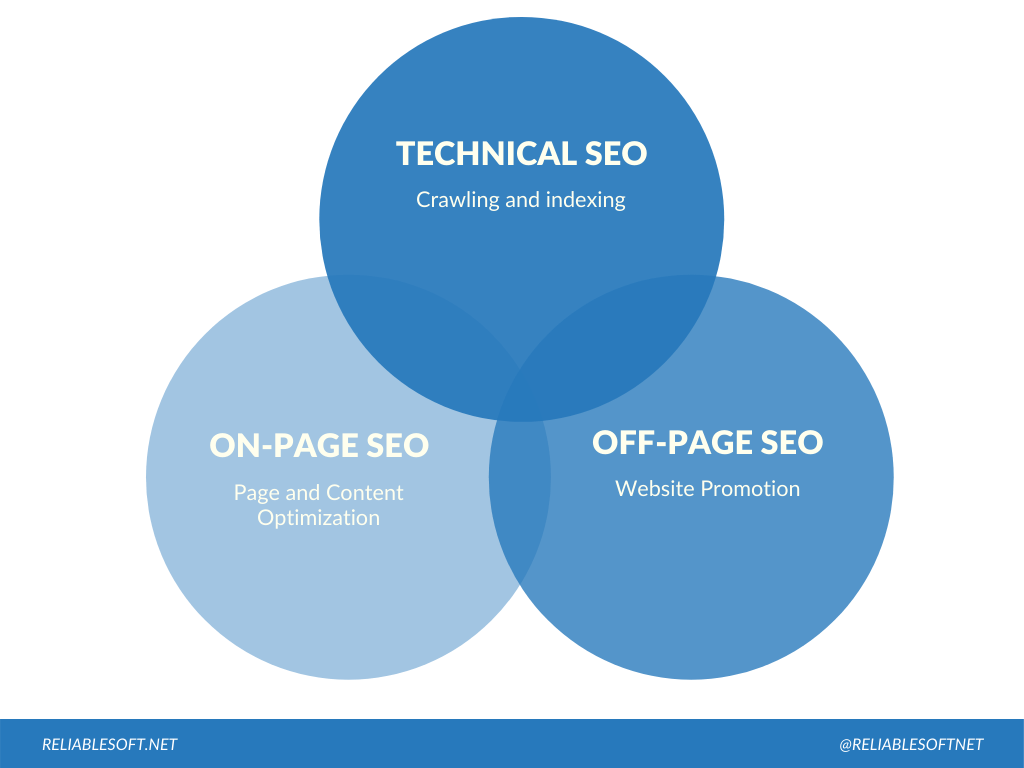
Each of these sub-processes deals with a number of factors and when applied together the end result is a fully optimized website that can achieve high rankings in Google.
Here is a quick summary of what each process includes. Don’t worry if something is confusing now, we will go deeper and explain everything in more detail, in the sections below.
Technical SEO: Technical SEO refers to the process of optimizing your website for the crawling and indexing phase.
With technical SEO, you can help search engines access, crawl, interpret and index your website without any problems.
It is called “technical” because it has nothing to do with the actual content of the website or with website promotion.
The main goal of technical SEO is to optimize the infrastructure of a website.
On-Page SEO: Your goal with on-page SEO, is to speak the ‘search engine language’ and help crawlers understand the meaning and context of your pages.
This is the part where you will start dealing with keywords and content marketing and work on optimizing your pages for particular keywords.
Off-Page SEO: Off-Page SEO has to do with website promotion methods – techniques that go beyond website design and content.
This is a critical part of the whole SEO process but you only have to deal with this after the other two processes (technical and on-page SEO) are completed.
Note: When you start learning SEO, you may come across other definitions like local SEO, mobile SEO, ecommerce SEO and content SEO. These are sub-sets of search engine optimization specific for certain types of websites.
For example, local SEO is more suited for businesses that have a physical presence and want to get more customers to their doors while eCommerce SEO is primarily for online shops.
KEY LEARNINGS
SEO will help you get more exposure in search engines. To make it easier to manage, the whole process is broken down into 3 main sub-processes which have to follow in the order shown above i.e. technical SEO, on-page and off-page SEO.
The basic SEO principles are the same for all kinds of websites and then depending on the type of your website (blog, corporate website, eCommerce website etc), you can apply specific rules to further improve the search rankings of that website.
Why SEO
If you are wondering why you need to practice SEO, either by becoming an SEO expert or by outsourcing SEO to professionals, the answer is simple.
Rank higher in Search engines
With SEO you will rank higher in Google and this translates to more website traffic. Traffic (visits), is the single most important element that can determine your website’s success or not.
Without traffic you will not have conversions, sales, subscribers or the attention your website deserves.
Drive targeted traffic to your website
Yes, there are other sources of traffic, for example, traffic from social media networks (think Facebook or Instagram), but no source of traffic is as targeted as organic traffic.
Users that type a search query in Google have a very specific intent while users on Facebook are browsing for fun or to catch up with their friends.
This make a huge difference when it comes to conversions. When you are selling something online, it is more likely to make a sale if you get a visit from Google than from Facebook.
The Google visitor has a need and is looking for a solution while the Facebook visitor may visit your website because of an ad or because of curiosity.
Note: A website conversion is when users perform an action you want them to perform. For example, subscribing to your newsletter, buying a product from your store, visiting your store, submitting a contact form etc.
‘Free’ Traffic 24×7
If your SEO is not working then to get traffic to your website, you have to pay for it. This is not necessarily bad if you can manage to run profitable PPC campaigns either on Google or Facebook.
The problem is that as soon as you stop paying for ads, your traffic will drop and you are back to square one.
With SEO, this is a completely different story. Once you get high rankings in Google and do all the necessary work to maintain your rankings, traffic will flow in 24X7.
Imagine the benefits this can bring to your business. Users will visit your website and you can make sales or get leads while you are sleeping.
To avoid any confusion and be completely accurate, the word ‘Free’ is a bit misleading.
Before you can reach the point of getting high rankings for the keywords you want, you will have to do a lot of work and this comes at a cost.
But, that does not change the fact that once you reach this stage, everything else becomes easier and the costs gradually go down.
SEO allows you to grow your business
There are no guarantees when it comes to SEO. Google is constantly making changes to their ranking algorithm and every time they do this some websites may gain or lose rankings.
But, if you don’t break any rules and work consistently on your SEO and have a clean history, you can have some sort of prediction as to the expected traffic levels.
This means that you can plan and execute the growth of your business.
For example, if you are selling services online and you know that for the past year you got 10 leads per month on average (from organic traffic), you can assume that this number will be similar next year and get new personnel to handle the extra workload etc.
Note: Organic traffic is a term used to describe traffic coming from Google (and other search engines), that is not paid for. This is not the same as paid traffic where you pay per click when someone clicks on a Google or Facebook ad and visits your website.
Top positions get the majority of search traffic
Let’s take a look at how the Google search results page is structured when you search for a query in Google. A typical page has the following components.
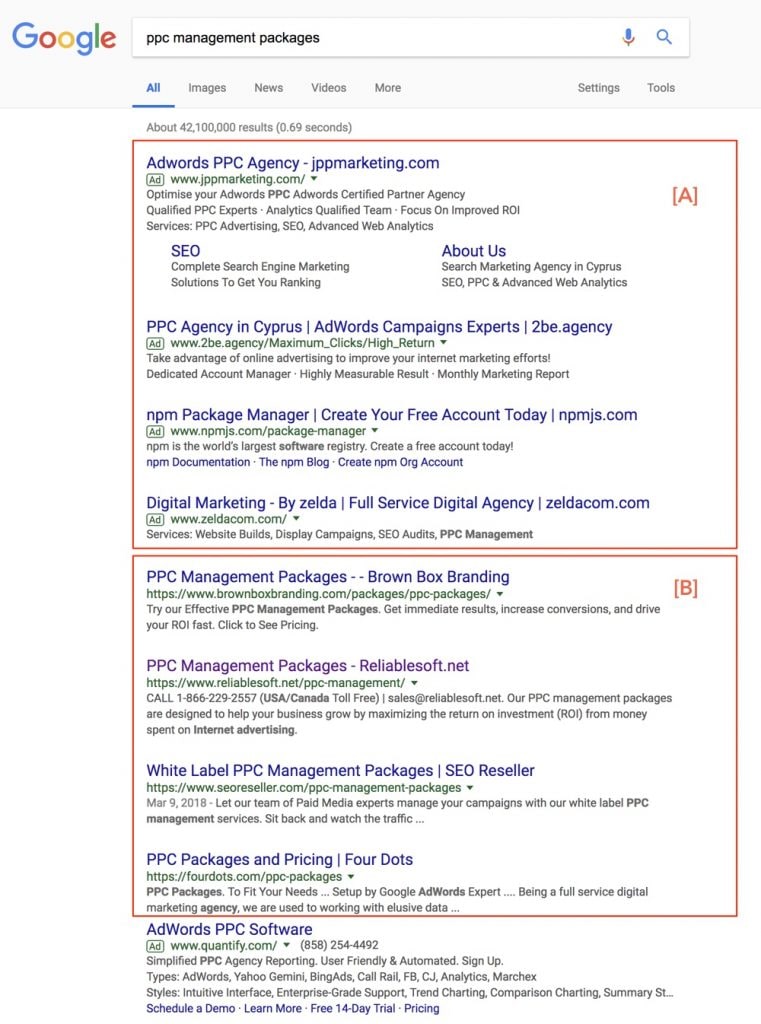
- Google Ads (Paid Traffic)
- Top results (Organic Traffic -> This is where SEO comes into play)
- People also ask section or Local SEO results (Google Map) or Videos
- More Organic results
- Related searches
The traffic is allocated as follows:

Source: SEO Tutorial
What does this mean? It’s simple. If you want to get traffic from Google and take advantage of the benefits of SEO, you need to rank not only on the first page of the results but on one of the top 5 positions.
Pages on the first page of Google get 73% of the clicks and pages in the top five positions get 67% of the clicks.
Other benefits of SEO:
Besides the above advantages, there are numerous other benefits of practicing SEO.
- Brand awareness – Websites in the top results are seen by thousands of users every time they search for a relevant query and this improves brand awareness.
- Brand trust – Users trust Google’s results and the websites that appear on the top.
- Increase in social shares – High ranking websites get more shares and mentions in social media networks.
- More backlinks – Other webmasters are more likely to reference (link) websites that appear in the first pages of Google.
KEY LEARNINGS
With SEO you can get more exposure in search engine result pages and this means more organic traffic to your website. Organic traffic is targeted and the most valuable source of traffic since it converts better than other sources of traffic.
Although there are no guarantees, if you manage to have solid SEO results for a period of time and you don’t intentionally or unintentionally break any rules, you can take advantage of all the benefits of SEO and get free traffic to your website 24 X 7.
The basics of SEO for beginners
Now that you know the theory behind SEO and why it’s important, let’s examine the basic SEO components in more detail and how each one can help you optimize your website for search engines.
Step 1: Technical SEO Basics
Help search engines find your content
If you take another look at the diagram of SEO components (above) you will notice that Technical SEO comes first.
Before even starting to think about SEO keywords and content, you need to ensure that crawlers can access and read your website without any problems.
Any problems with technical SEO can destroy your efforts, that’s why it is important to get your technical SEO right before proceeding to the next steps.
At this stage, you need to check and optimize settings related to:
How your domain is setup – In the SEO World, a domain with www in front is not the same as a domain with no www in front.
Google considers these to be two different websites:
- https://www.example.com (with www)
- http://example.com (with no www)
Having two websites with exactly the same content is not a good thing for SEO, so the first thing to do is to ‘tell’ Google which domain version you prefer to use.
Which pages are accessible by search engines – I mentioned above that search engine crawlers will try to index all pages that are publicly available on the Internet.
Sometimes this is not what you might want for various reasons. For example, you have pages that are for your employees only or pages that you want only Facebook visitors to see.
You can control which parts of your website you want search engines to index through a file called robots.txt. This file resides in the root folder of your website and provides crawlers with instructions as to which files/directories of a website they can access.
Site Structure and Navigation – Site structure is very important for SEO. Websites need to have a hierarchical structure that is simple to navigate both by crawlers and users.
If you are starting a website now, you should spend some time thinking how your website will be structured.
A common mistake made by many designers is to concentrate on the appearance of a website, without thinking about structure and navigation.
When crawlers discover a website, they start the indexing process from the homepage and then they follow all links from there.
This means that you need to make sure that any page of your website is accessible in less than 3 clicks, by following links from the homepage.
URLs – Besides choosing a good domain name and designing a site structure that is easy to use, you should also optimize your URLs.
The URLs, also known as slugs or permalinks, should accurately describe what the page is all about.
For example, consider these two URLs:
- https://www.example.com/343/bg/page.html
- https://www.example.com/what-is-seo
The first is an example of a bad URL, while the second is an example of an SEO friendly URL.
Notice how easy is to understand what the second URL is all about. Users and search engines have a big clue as to what to expect from that page before even looking at the actual content.
What happens when a user is looking for a page that is no longer available – Sometimes when you click a link you end up seeing an empty page or a page with some technical terms you don’t understand. This is not a good experience for users or for crawlers.
There are ways to control how your website will behave in such situations. Instead of showing users an empty 404 page, you can give them options on how to find what they are looking for.
Page Speed – I’ve mentioned above that page speed is one of the known ranking factors. Google likes fast websites and decided to reward them by giving them a small ranking boost.
Your job as an SEO is to make sure that your website loads as fast as possible. This means you need to check your server infrastructure and a lot of other things that are related to the speed.

If this is too technical, you can hire a developer but the end result should be a website that loads in less than 3 seconds on both desktop and mobile.
Failure to do so can negatively affect your rankings and conversions.
Website security – Besides speed, Google also likes secure websites. Installing an SSL to make your website https is no longer optional.
Mobile friendly – more than 60% of searches are now performed on mobile devices. This means that your website has to be mobile-friendly and offer a great experience to users on mobile.
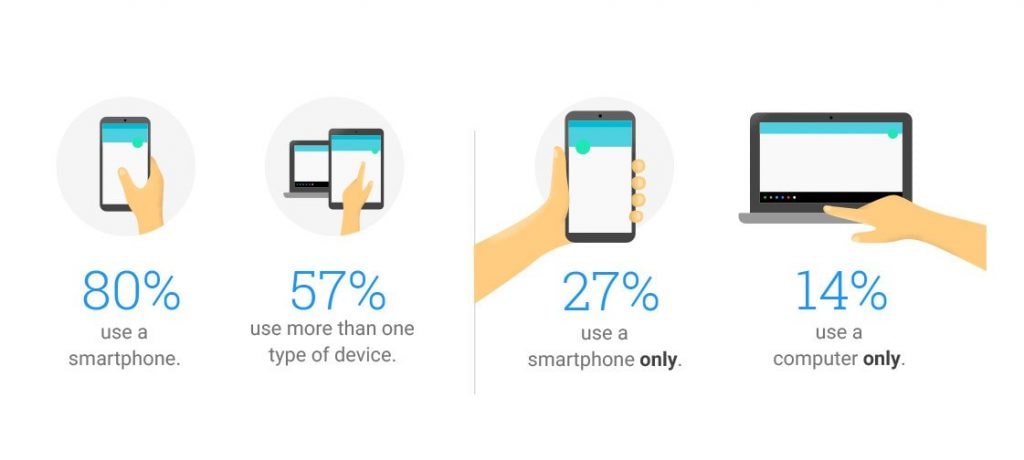
Google is taking mobile very seriously and that’s why they created a mobile-first index that will be used to better serve mobile searches.
Part of your technical SEO review is to test your website on different mobile devices and ensure that it loads fast and easy to use.
How to configure a website that is available in more than one language – When you have a website that is available in more than one language, there is a special SEO configuration for that.
When you have a post that is too big and is broken down into a number of pages, there is also a way to deal with that so that Google can understand that it’s the same post but broken down into multiple parts.
KEY LEARNINGS
The above are just some of the parameters you need to check or configure related to technical SEO. That’s the part of SEO that you may require the assistance of a developer if you don’t have the technical knowledge to do the changes yourself.
What you need to understand at this stage is that technical SEO settings are not directly related to the actual content of a website but have to do with the technical SEO infrastructure.
Many of the technical factors can be solved by using an SEO friendly theme for your website. Have a look at my recommended SEO Tools post, for recommendations on SEO friendly themes.
Step 2: Keywords in SEO
What users are searching for
What is a keyword?
I’ve already mentioned the word keyword a number of times so far in this guide. It’s without doubt one the most commonly used terms in SEO, for a reason.
A keyword is a word or phrase that users enter into the search box.
A keyword can be a single word like ‘SEO’ or ‘shoes’ or multiple words like ‘what is SEO’ or ‘Indian restaurants near me’ or even more words like ‘what is the difference between SEO and SEM’.
Once the search button is pressed, search engine algorithms try to find and return the best pages related to the search term used.
Your job as an SEO is to make it obvious to both search engines and users as to which keywords your content is related to.
If you do this successfully, your content has more chances of appearing high in the results for your chosen keywords.
Of course, not all keywords are equal. A lot more people are using Google to search for ‘sports shoes’ than ‘parrot cages’.
A person searching for ‘men running shoes’ is more likely to become a customer than a person searching for ‘will it rain tomorrow’.
What is very interesting is that according to Google, 20% – 25% of the search queries are new and Google has never seen before. This means that people enter billions of keywords in the search box that were never searched before.
This creates a great opportunity for website owners (and SEO’s) to create content targeting those keywords.
You can use Google trends, a free tool by Google which gives you more details on what people search for.
It’s not just about keywords
Over the years Google managed to move past keywords and understand the actual intent of the user without relying on the actual query entered into the search box.
For example, if you search for ‘how to lose weight on your stomach’ Google can understand that you are looking for ‘ways to reduce belly fat’ and will return relevant results to satisfy your intent.
This means that when optimizing your content, you should also take into account the relevancy of your keywords and not just their exact meaning.
What is keyword research?
How to find keywords that matter for your website
Keyword research is the process of finding out what users are searching for so that you can optimize your content and website to satisfy their intent.
Let’s say that you have a website selling ‘swimsuits’. Before deciding the structure of your website or how to organize your products, you can perform keyword research to find out what words users are using related to ‘swimsuits’.
EXAMPLE 1
To do this you need a tool and there are a number of free and paid tools available. I’m using SEMRUSH which is one of the most powerful tools in the market but as a beginner you can start with the keyword planner tool, a free tool from Google.
When you enter the word ‘swimsuits’ in SEMRUSH you are presented with a number of details like how many people search that keyword on Google every month (Volume), how difficult that keyword is in terms of competitors (KD) and how much it cost if you are to use PPC ads targeting those keywords (CPC).
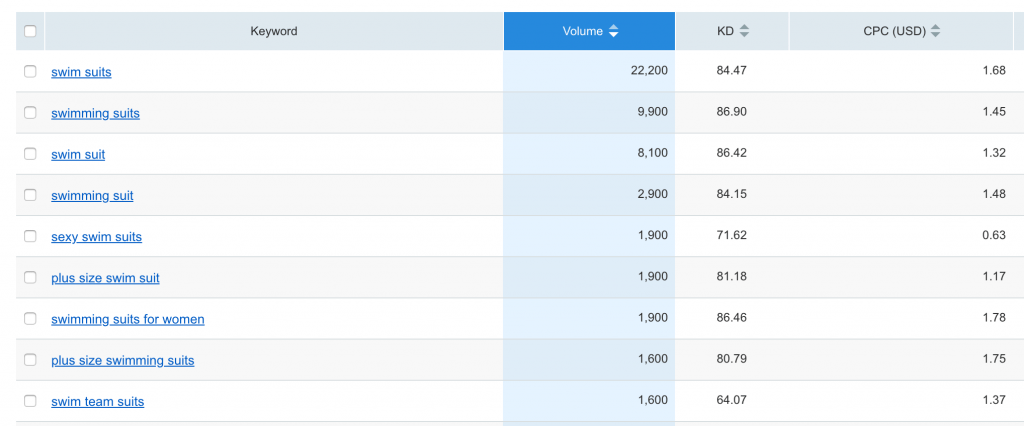
You are also presented with a list of related keywords.
It is clear from the example above that most people use the term ‘swimsuits’, instead of ‘swimming suits’ and that a lot of people are looking for ‘plus size swimsuits’.
These are all great keywords to target in your content. This information tells you that you need to create the following categories in your shop: ‘Plus Size Swim Suits’, ‘Sexy Swim Suits’ and ‘Swim Suits for women’.
EXAMPLE 2
Let’s see another example related to content most suited to informational type blogs, like a food blog.
You are thinking of publishing recipes related to ‘avocado’. You go to SEMRUSH to do your keyword research.
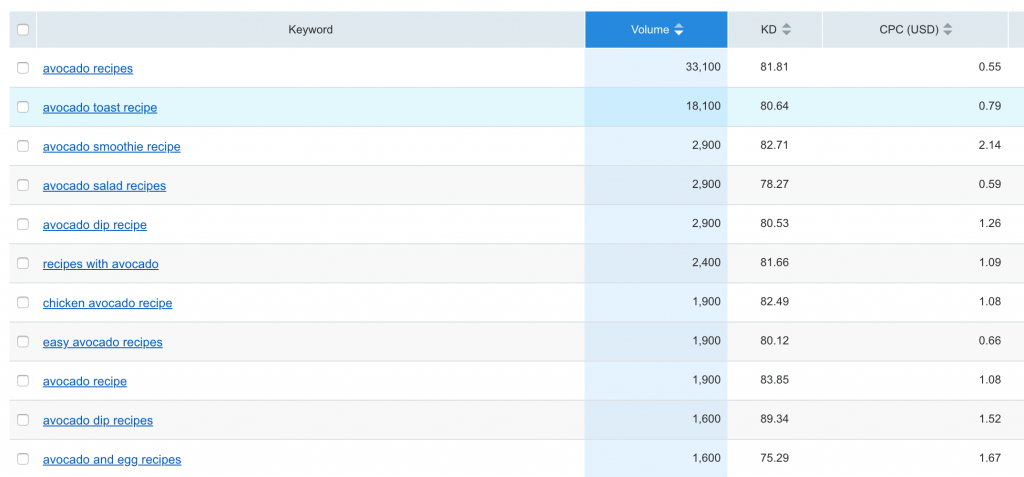
It is clear from the above results that people like ‘avocado recipes’, especially ‘toast recipes’ and ‘smoothies’.
Long-tail keywords
It is normal that the above keywords are highly competitive too. Searching for ‘avocado toast recipes’ in Google returns 46 million pages!!

This means that your chances for ranking for that search term are limited, especially if you are starting out now.
What is the solution in this case? Long-tail keywords.
Long-tail keywords are search queries that include a number of words and generally have a lower search volume but also less competition.
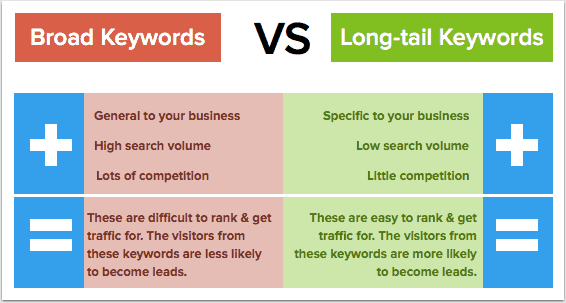
This creates a huge opportunity for SEOs since they can create content to target those keywords and actually have some chances of getting high rankings and traffic from Google.
SEMRUSH has a number of options that allow you to drill down and filter the keywords to find long-tail keywords that are easier to target.
‘Avocado black-eyed pea salsa recipe’ is a long-tail keyword that is worth targeting.

Are meta keywords important for SEO? You may have come across the phrase ‘meta keywords’ which are keywords entered in the header of a webpage to describe the content of a page.
In the early stages of SEO this was a way to tell search engines what a page is about. Over the years search engines have stopped using meta keywords information so they are no longer important or used by search engines.
KEY LEARNINGS
Keyword research is a critical step in SEO. What I demonstrated above are just two very simple examples of why you need to do keyword research before writing your content.
A good keyword research exercise will give you enough information as to how to structure your website, how to name your categories and which keywords/topics to target in your posts.
Finding and searching for keywords you can actually rank for can be tricky at the beginning but as you gain more experience, you will find it easier to spot which keywords are good candidates for your posts.
You need a tool to perform keyword research successfully and SEMRUSH is one of the best tools in the market.
Step 3: On-Page SEO Basics
Help search engines understand your content
The next step in the process is to optimize your pages and content. Your goal at this stage is to help search engines understand the context of your content and for which keywords you want to rank for.
The on-page SEO process can be broken down into two parts:
- Optimizing page properties like the page title, page headings, etc.
- Content optimization
On-Page SEO Optimization
As the name implies, on-page SEO has to do with settings/rules that are applicable on a page level.
Note: Before we continue, it should be noted here that Google algorithms rank web pages and not web sites. In other words, the most important factor is the quality of a particular page rather than the website as a whole. Of course, Google will never rank a page if the website is of low quality but the opposite is also true. Just because the website is of high quality, it does not mean that all web pages will rank high.
The most important on-page SEO factors are:
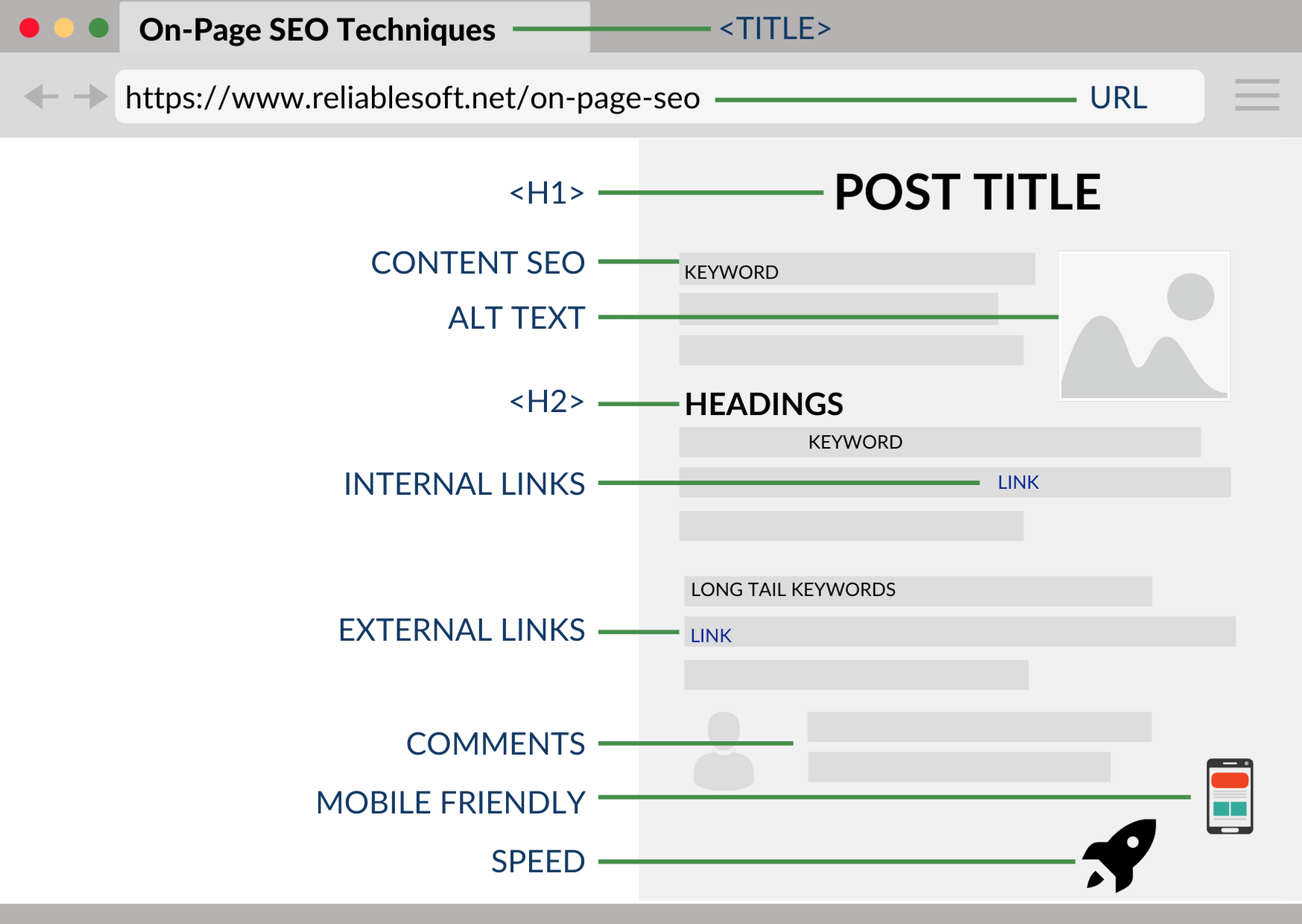
Page title – Each and every page of your website needs to have a unique title. The title of the page was a very important SEO factor since the beginning of Google, and it is important today.
The page title is what users see in the search results and the first element that crawlers read.
A good title should be interesting for the users to click, descriptive of the page content and to have keywords that users (and search engines) can recognize.
Page Description (Meta Description) – The meta description is not visible to users but may be shown in the search results if it’s chosen by Google.
The meta description of the page is a short summary of the page and unlike the meta-keywords (mentioned above), they are taken into account by search engines.
Main heading (H1) – Besides the page title, another important on-page SEO element is the main page heading.
In the HTML language, this is the <h1> tag of a page. Good SEO practices dictate that a page should only have one h1 tag.
Subheadings (H2, h3) – Besides the H1, a post or page needs to have multiple sections to make it easier to read by users. The use of headings should be done hierarchically. In other words, the main title is H1 and then subheadings can be H2 or H3.
Look at this guide for example and see how I used the different headings to make this really long post easier to read.
Optimization of images, audio, and video – Not all content is text. A website can also publish videos, audio (podcasts) and images.
Google cannot easily understand what an image is all about or what kind of content is presented in a video.
To make their job easier, there are some SEO rules to follow to make your images and other multimedia elements SEO friendly.
For example, when adding an image to a page, you can make use of the ALT text to describe the image in words. Search engines when they find the image, they will read the ALT text and add it to the appropriate category in their index.
Content Optimization (Content SEO)
Content optimization is all about the content and this is the stage where you should spend most of your attention.
There is a saying in SEO, ‘Content is King’ and this is tightly related to the reason Google has become so successful.
Google has a very simple mission “to provide users with high-quality results so that they can come back for more searches”.
This means that if your content is not king, you will not survive from the quality checks made by the Google algorithms during the ranking process.
Even though your content is not going to be read by humans but by computer bots, their process is so advanced that they can easily identify good content from low-quality content.
To do this they use a number of signals including how users interact with the search results but I won’t go into the details here since it can become really confusing for beginners.
What you need to understand at this stage is that the quality of your content is the most important ranking factor of all.
A website with great content can do well in search with or without SEO.
What do we mean by quality content?
High-quality content has the following characteristics:
- It is unique for the particular web site and has not to be published online before.
- It’s thorough and explains a topic in detail. Take the guide you are reading now as an example. It’s 9000+ words long and covers SEO basics from start to finish.
- It is well-formatted and not just words thrown on a page.
- It’s unbiased and tells both sides of a story
- It’s authoritative based on experience, research studies, and data.
- It’s SEO friendly.
KEY LEARNINGS
On-page SEO is not hard. Once you do your keyword research then you need to follow the guidelines to incorporate those keywords into your pages and content.
Exaggerations are not good for SEO and this includes keyword stuffing at all levels. Keyword stuffing is then you repeat the same keywords all over the place not because they are good for users but to trick search engine algorithms. Doing so repeatedly can produce exactly the opposite results.
When optimizing your content, the first thing about the user and what they like to see in an article or page and then start thinking about SEO.
What you have read above it’s just the tip of the iceberg of on-page SEO. Make use of the ‘further reading’ recommendations to go deeper into each topic and get a better understanding of why and how to optimize each element.
Step 4: Content marketing Basics
Let’s recap what you have learned so far.
SEO starts with optimizing the technical aspects of a website. Once this is in place you do your keyword research and then try to create high-quality content optimized for those keywords.
The process of repeating the last two steps (keyword research and content creation) and publishing content that can satisfy the user intent is called content marketing.
Content marketing is at the center of every SEO campaign.
Think about it for a moment. What is the Internet? It’s a vast collection of webpages providing information to users via search engines.
So, to have any chances of succeeding online, you need content and in many cases lots of content.
Yes, there are websites or products that can do well without having a lot of content but that’s the exception and not the rule.
How content marketing can help you with SEO?
There are millions of pages already available on the web for every topic you can imagine but some of them are outdated and a lot of them can certainly be improved.
The way to take advance of this for your benefit is to find out which keywords related to your business, you can create better content.
By better content, we mean to create something that is different (more insightful, more thorough) from what is already published online.
Publishing content that is as good as what is already published will not get you anywhere.
Give reasons to users to be excited with your content so that they share it in social media or reference it from their websites.
Do that consistently and for a period of time and soon enough Google will pick up these signals and your traffic will gradually grow.
KEY LEARNINGS
Creating high-quality content is not easy. It takes a lot of time and effort and It’s perhaps the most expensive activity compared to other SEO tasks.
What you need to understand from the beginning is that while you need content for exposure in search engines, you don’t need any type of content. You should concentrate your efforts on publishing content that is better than what is already published online for a specific keyword/topic.
Give reasons to users and search engines to ‘like’ your content and do this consistently and sooner or later, you will get better results.
Step 5: Off-Page SEO
Promote your website on the Internet.
I have mentioned above that Content is King and that Google is pretty good at differentiating great content from mediocre content.
One of the parameters taken into account by the Google ranking algorithm that has a lot of weight is how popular a webpage is on the web.
Popularity, in this case, refers to how many backlinks a webpage has from other related pages on the web.
The process of promoting your website on the web to increase its popularity is called off-page SEO.
PageRank
Let’s take it from the beginning.
Back in the 1990s when Google was at its early stages, Larry Page and Sergey Brin created a system to calculate how valuable a page is.
They thought that a page that has more references (links) from other pages on the web is more important and useful to other users than pages that have fewer references or no references at all.
They called this system PageRank.

As you can see in the diagram above, backlinks make a website stronger and more popular and this means higher rankings in the Google search results.
A backlink is a link that points from one domain to the other. For the website that links out, it is called an “outbound link” and for the website that receives the link, it is called an “inbound link”.

Backlinks act as a vote of trust and this is taken into account by the Google algorithm during the ranking process.
How important are backlinks in SEO?
Over the years Google tried to find a way to rank websites that were less reliant on backlinks.
Despite their efforts and a number of tests performed, they concluded that webpages with a greater number of inbound links are indeed more useful to users than pages with fewer links. So, backlinks are still very important for SEO.
A website with great content and good on-page SEO can get to the first page of Google. A website with great content, good on-page SEO and backlinks can get to the top positions.
Link Building
From the above statement, it is clear that in order to achieve high rankings in Google, you need backlinks. The obvious question is how to get them? Are all links equal?
This is how the term link building was born. As Google grew in popularity, webmasters realized the importance of backlinks and they started building links from other websites to satisfy the algorithm needs, get higher rankings and more traffic to their websites.
The problem is that soon this situation went out of hand. The web was flooded with websites that their sole purpose was to provide links to other websites without adding real value to the web or to users.
These were known as link directories and later as article directories.
The end result was that low-quality websites started appearing at the top of Google search results not because they provided great value to the users but because they had a lot of backlinks.
Google’s priority was (and still is), to provide a great experience for users so they took a number of actions to protect their search results.
Google Penalties
This is how Google penalties were born. Google added more rules to their ranking algorithm to differentiate good links from bad links.
Websites that have a lot of bad backlinks are imposed a penalty and this means that either their rankings are reduced or they disappear from the Google index.
To help webmasters comply with their policies they also introduced a set of guidelines giving more information about links and what is allowed or not.
What is a good link?
- A link added by a webmaster without monetary compensation
- A link coming from a related website
- A link coming from a website that is trusted by Google
- A link that adds additional value to the users of that website.
Any links that don’t fall in one of the above categories are considered bad links and should be avoided if you want to stay out of trouble.
How can you get backlinks to your website and improve your rankings?
In a nutshell, the best way to get links from other websites is to create superb content that other webmasters will find useful and will reference it from their websites.
This is also called natural link building and it’s the safest way to improve your Google rankings.
The problem is that although you may have great content on your website, not a lot of people can find it (since it has low rankings) and this means fewer chances of getting links.
Do Facebook like count as links?
This is where social media comes into play. Links from social media networks like Facebook or Twitter do not have a direct impact on your rankings since they are not counted as ‘links’ by the algorithms, but they can help in getting your great content in front of people that can potentially link to it.
Email Outreach
Another way is email outreach. Finding the emails of people that blog about similar topics and emailing them to let them know about your great content is another way to promote your website.
This works provided that you avoid spam techniques by starting to send massive emails to everyone that has a website.
KEY LEARNINGS
I know from experience that beginners to SEO find it difficult to understand the concept of links and link building but this is perfectly fine.
Link building is one of the most challenging parts of SEO and it takes time and experience to get it right. Lesson 6 of The Complete SEO Course explains everything you need to know about link building and off-page SEO in general.
What you need to understand at this stage is that backlinks are important in SEO. Google and other search engines take them into account when calculating the position a website will appear in the results, for a given search term.
It’s not a numbers game. In other words, it’s not important how many backlinks you have but from where these links are coming. Links from websites that already have good Google rankings and have content related to your website have more value than links from forums or other low-quality websites.
When building links, you should not forget that violating any rules (i.e. by buying links or participating in link exchange themes), will get you into trouble. When your website is imposed on a Google penalty it will lose its rankings and it’s very difficult to recover.
If you are starting out now, then your priority is not off-page SEO. You should first make sure that you create an easy to use website that has high-quality content and then starts thinking about links and how to get more eyes to it.
SEO BASICS: Summary
SEO is a dynamic discipline. The Internet is growing fast, search engines are constantly changing their rules to provide a better experience to users and thousands of webmasters and SEOs are trying to rank their websites high in the results and get a share of the traffic.
Beginners to SEO have to face a very big challenge. There is a lot to learn and a lot to try to reach a point where the above statement makes sense. Don’t’ get disappointed.
There is room for everyone on the Internet and if you do consistent work, you can get enough traffic to your website to build a business, make money through ads or otherwise.
The best way to learn SEO is to take it step by step.
First, try to understand what we want to achieve with SEO in general.
SEO is not about cheating search engines but making their job easier. Crawlers have to visit millions of pages and if they cannot find the right signals to understand what your website is all about, they will move on to the next.
Second, work on your technical SEO. Successfully completing this step will ensure that your website can be index by search engines without any problems.
Third, familiarize yourself with the keyword research process. Learn how to do keyword research and how to pick keywords you can actually rank for.
Fourth, spend some time thinking about on-page SEO and content optimization. The rules to follow are simple, all you need to do is to understand how to embed your keywords into the content without overdoing it.
The fifth step is to start thinking about content marketing. A website is like a business and the content of a website is the assets.
Without content, don’t expect to rank for anything; that’s how the online world works. Websites that can produce high-quality content on a regular basis win the race.
The sixth and final step is to go out and promote your website in the best ways you can.
Make connections with other bloggers on Facebook, create a list on Twitter, share your latest posts on Pinterest and Instagram.
Anything you can do to bring your website in front of the eyes of other webmasters that are more likely to link to you is highly desirable.
What to do next?
If you have made this far, congratulations! You already made a great first step in learning SEO.
It’s normal that some things may not make a lot of sense now, especially if you have read this for the first time. Don’t get disappointed, SEO is not something you can learn overnight.
It will take a lot more reading and practice to fully understand what it takes to have a fully optimized website but it’s not actually rocket science.
SEO is a discipline that can be master by anyone wishing to allocate the necessary time in reading about SEO and trying things in real life.
SEO is not a theoretical concept but it’s practical and the only way to find out if you know SEO is to set up a website and try to rank it in Google.
If you don’t have a website yet, then start a new blog. Chances are you will not get it right from the first time but it’s a great opportunity to test your knowledge and learn from your mistakes.





Perfect. thank you so much for this complete article.
Hi Arash
Thanks for your comment.
Alex
Hey Alex, wow what an interesting, full guide to the basics of SEO! Nice one!
Hi Matt
Thanks a lot, glad you liked it!
Alex
This article is really a big help to those who are starting to learn the in’s and out’s of SEO process. Cheers.
Hi Tom
Thanks a lot, good luck with SEO.
Alex
Hello!
Awesome post and this is especially helpful for those who are new in the SEO field.. You have listed great ways. Thanks for this informative post. Have a great day. keep posting.
Hi Priyanka
Thanks a lot. My goal was to help beginners to SEO by providing them with a summary of what SEO is all about.
Thanks
Alex
Hi Alex, This is really The Article Which I Want Need To Prepare My SEO Overall.
Here in this article all parts are mentioned in short and easy to understand. Very interesting to Read ☺️!!!
I have no words to say you thanks for this post!! Because my mostly problems solved by this post. Again to thanks for this!!
Hi Rai
Great comment, thanks a lot!
Alex
The ultimate juice of information you have shared that is a complete guide to business owners!
Great Content. I was looking for a well written and easy to understand post and this was a great relief to find. It has helped get a better understanding of SEO. Thanks for sharing
Hi Daksh
Thank you are well for reading and commenting.
Alex